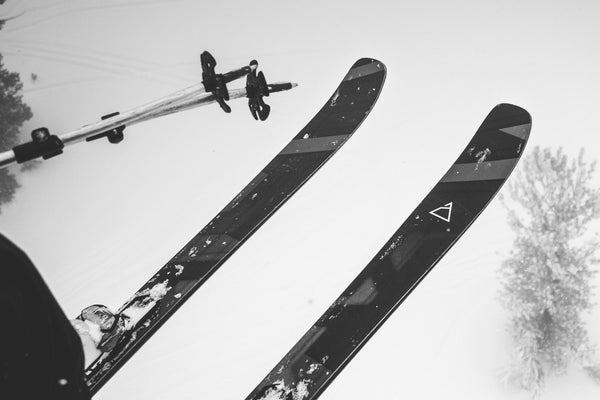It’s about time someone admitted it. We all know but are too scared to talk about it.
As the owner of a ski company, I’ll just say it: Skis are terrible for the environment.
There, it's been said. The world is still here. Your skis didn’t run and hide from you, and winter will still come. But I think it’s about time a ski company talked about the truth behind what it takes to create the skis we all love so much. The irony is nature has always been the backdrop of skiing, innocently hiding the dirty truth in plain sight.
"The irony is nature has always been the backdrop of skiing, innocently hiding the dirty truth in plain sight."
The U.S. sees 51 million skier visits each winter, over twice the number of seats the NFL fills in a season. Worldwide, the number quadruples to 220 million visits. All those skiers need something to get them down the hill, purchasing about 850,000 pairs of skis per year in the US and 2.3 million pairs worldwide. These skis come from somewhere, and that’s where we, ski manufacturers, come in.
The supply chain of a typical ski company is a global affair. Materials are sourced from around the world, assembled, and then redistributed internationally to customers and athletes in some of the most remote locations imaginable.

Sourcing modern ski materials is now a global affair. This map shows where we get our materials from.
Building skis is a dirty business.
Once raw materials are imported, they are prepared to become skis with very tight tolerances. Herein lies the problem: many materials have slight variations in thickness, humidity, or width and are subject to warping and internal fiber tensions. This makes it extremely difficult to put the materials into the precise mold of a world-class ski. Much like woodcarvers trim and shape a rough log before they can begin the process of making a masterpiece, ski manufacturers must trim and prepare materials before building a ski. During this process, over 40% of the material is scrapped. These scraps are often coated in epoxy, making the energy of upcycling greater than the initial offense.

We are very aware that an incredible amount of material is wasted during the process of creating a ski. The hunt for a more environmentally friendly alternative is certainly not lost on us. We also wouldn’t be the first to abandon the idea because, after crunching the numbers, these "green" alternatives pollute up to four times more than their conventional counterparts. So, if you see a company claiming that their skis are green, feel free to call BS. A specific component might be easier on the environment downstream, but how much energy did it take to create in the first place? What was the upstream environmental cost of that part?

We're carbon neutral.
So, if building skis is wasteful, and green alternatives are even worse, what’s next? First, we need to come clean about the harm we’ve been causing and accept responsibility for our impact on the environment as skiers. Feigning ignorance is worse than the offense. It's time we stop trying to hide this fact.

Second, offset it. Our supply chain may be intricate and our distribution networks complex, but at its root, a ski company is no different than any other global business. With this in mind, we’ve committed to taking an honest look at the lifecycle of our products (upstream and downstream) and to offset our carbon footprint in its entirety. If we are true skiers, pursuing a path of carbon neutrality is the most obvious and imperative decision we can possibly make.
"If we are true skiers, pursuing a path of carbon neutrality is the most obvious and imperative decision we can possibly make."
To take this step, we chose to partner with Climate Neutral to offset our entire carbon footprint in 2020 and beyond. We are the first ski company in the world to do so and are excited to see others already making the switch. The decision to go carbon neutral is certainly not the full solution — it’s just the first step. While we continue to find ways to reduce and eliminate our footprint, it serves as the foundation for our decision-making as we move toward climate honesty. We are taxing ourselves the true cost of doing business — and going carbon neutral is the first tax.
While ski construction is largely a standardized process (apart from embedding our patented VibeStop™), we continue to search for ways to reduce our impact outside of ski production. This includes tighter tolerances on packaging and reducing packing materials like unnecessary tags, string, wrapping, and tape. We also don’t label our skis by model year (2020, 2021, etc.) in an effort to avoid obsolescence. Instead, we’ve opted for "versions" (v1, v2, v3, etc.) which represent incremental changes to design that are quietly phased into our production cycles — often without customers even knowing they have purchased a new and improved version.

What's next.
Going carbon neutral and offsetting every ski we make is a small step, but it hasn’t stopped us from making the first moves in transparency. Here is more information about what we are doing for our own sustainability, and here’s what you can do to help:
- Don’t buy new skis — Ski yours for one more season. A good pair of skis should last at least 100 days on snow. Choosing a high-quality ski can help reduce the total number of skis you consume in your lifetime.
- If you are going to buy new skis, upcycle and get $100 in Renoun credit (yes, it’s a bribe) — Send us your old ones and we’ll give them to someone else to be reused instead of putting them in the landfill.
- Be choosy — From your food to your car to your skis, you can choose who you support. There is a growing list of ski brands joining this movement, like Season Eqpt, Icelantic, and WNDR.
In the future, the success of a business will not be in spite of commitments to the climate but because of these commitments. The stakes are too high for us to continue business as usual at the expense of our future. Personally, I plan on skiing for the rest of my life. I can't, in good conscience, hold this goal while ignoring the environmental consequences that result from creating the product I use to achieve this goal.
We, Renoun, choose to act.
Read more about our sustainability.
Re-think | Re-invent | Renoun






